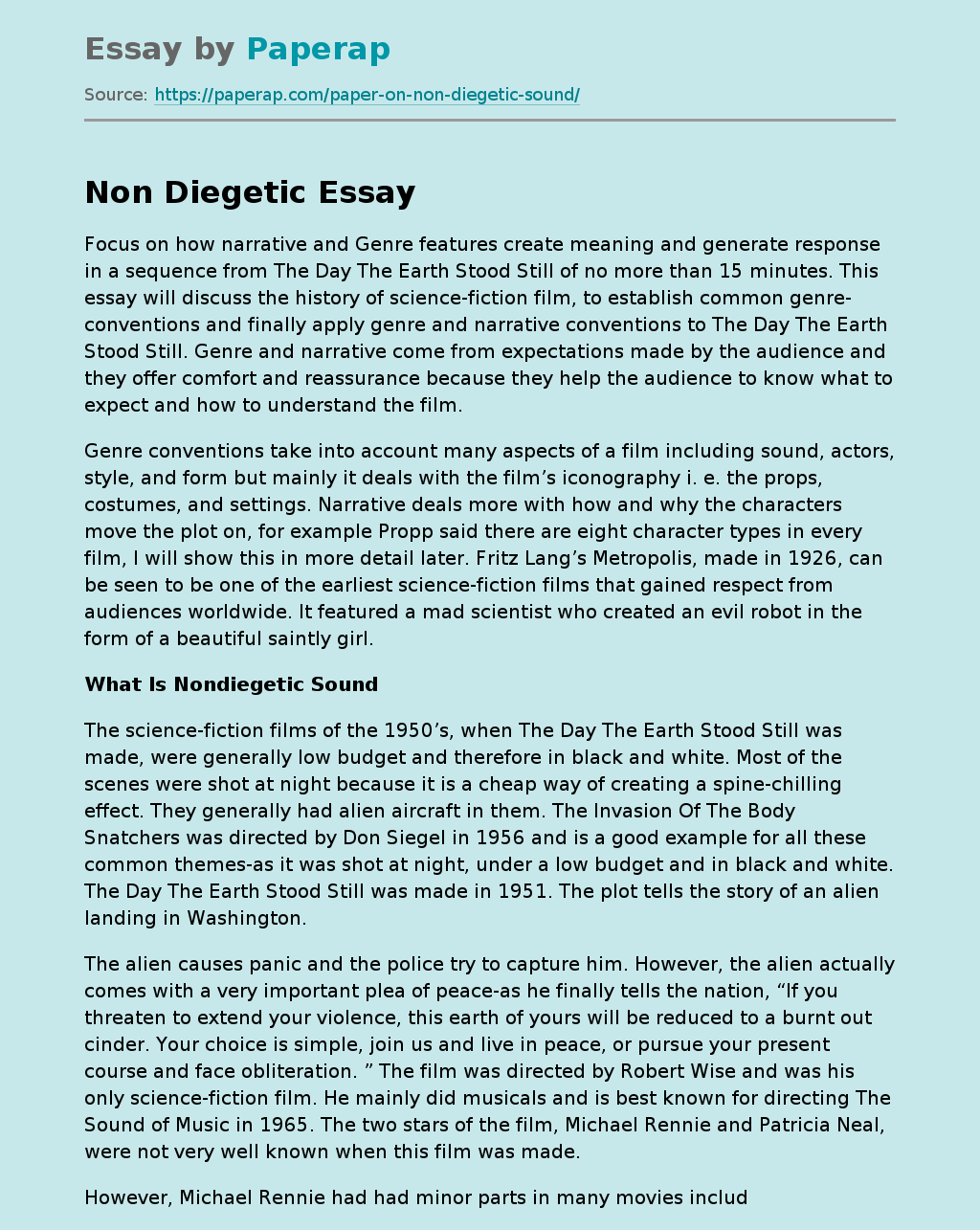What Is Nondiegetic Sound
The following sample essay explains what a non-diegetic sound is. To read the introduction, body, and conclusion of the essay, scroll down.
Focus on how narrative and Genre features create meaning and generate response in a sequence from The Day The Earth Stood Still of no more than 15 minutes. This essay will discuss the history of science-fiction film, to establish common genre-conventions and finally apply genre and narrative conventions to The Day The Earth Stood Still. Genre and narrative come from expectations made by the audience and they offer comfort and reassurance because they help the audience to know what to expect and how to understand the film.
Genre conventions take into account many aspects of a film including sound, actors, style, and form but mainly it deals with the film’s iconography i. e. the props, costumes, and settings. Narrative deals more with how and why the characters move the plot on, for example Propp said there are eight character types in every film, I will show this in more detail later.
Fritz Lang’s Metropolis, made in 1926, can be seen to be one of the earliest science-fiction films that gained respect from audiences worldwide. It featured a mad scientist who created an evil robot in the form of a beautiful saintly girl.
The science-fiction films of the 1950’s, when The Day The Earth Stood Still was made, were generally low budget and therefore in black and white. Most of the scenes were shot at night because it is a cheap way of creating a spine-chilling effect.
They generally had alien aircraft in them. The Invasion Of The Body Snatchers was directed by Don Siegel in 1956 and is a good example for all these common themes-as it was shot at night, under a low budget and in black and white. The Day The Earth Stood Still was made in 1951. The plot tells the story of an alien landing in Washington.
The alien causes panic and the police try to capture him. However, the alien actually comes with a very important plea of peace-as he finally tells the nation, “If you threaten to extend your violence, this earth of yours will be reduced to a burnt out cinder. Your choice is simple, join us and live in peace, or pursue your present course and face obliteration. ” The film was directed by Robert Wise and was his only science-fiction film. He mainly did musicals and is best known for directing The Sound of Music in 1965. The two stars of the film, Michael Rennie and Patricia Neal, were not very well known when this film was made.
However, Michael Rennie had had minor parts in many movies including The Wicked Lady in 1945. This film was made in the heart of the cold war, a time when, in America particularly, anti-communist views were held strongly in the West. The McCarthy witch-hunts of communists in public life and the arts led to the blacklisting of many writers, actors and directors. There was such a fear of communism at this time that this film’s anti-war message could have been seen by some as being unpatriotic. It was thus a very brave film to make but, thankfully, Robert Wise wasn’t black listed and went on to direct many more classic films.
The film carries its message on today, when after September 11 it is hard for American’s to argue against a possible war against Iraq. The best art has always carried messages that can be read by all people at all times. The extract I have chosen to study out of The Day The Earth Stood Still is near the end of the film. It starts with Klaatu and Helen on the way to the spaceship where Klaatu is going to make his speech. Klaatu tells Helen that Gort has the power to destroy the earth if he isn’t there to stop him, but Klaatu is then shot by the Army and presumed dead.
However, thanks to Helen, Gort saves his life in time for Klaatu to make the speech. Like many 1950s science fiction movies this extract is set at night, to try to create a tense atmosphere. The non-diegetic sound is very mechanical, reinforcing the idea that this film is part of the science fiction genre. It also has a trembling effect and some very sharp staccato notes to create the tension felt in this extract. The music is only played when Gort is in shot emphasising his mechanical nature. The spaceship is made out of smooth shapes, and man-made materials, – for example plastic and metal.
This emphasises how much more advanced the aliens are than the humans as they are using materials we know very well to create something that we couldn’t achieve at that time. The effects of the electric doors and the platform dissolving into itself add a futuristic effect to the spaceship. The figure of Gort is the main icon that shows this extract to be a science fiction film. His costume is silver, a colour that is connected to metal and therefore robots, and in place of his eyes is one bright light. Gort can be seen as similar to robots that appear in later films.
For instance in West World, made twenty years later, the robots have the power to kill us quicker than we can kill them, and in Terminator the robots are gaining complete control over the world. This parallels the way in which in DESS the other planets have given complete control to Gort and his kind. Fear is an important aspect of any science-fiction film; and in this film Gort provides the main element of fear. Even Klaatu says he fears his power, “I’m afraid of what he might do if anything should happen to me… There’s no limit to what he could do, he could destroy the earth”.
What Is Nondiegetic Sound. (2019, Dec 05). Retrieved from https://paperap.com/paper-on-non-diegetic-sound/

